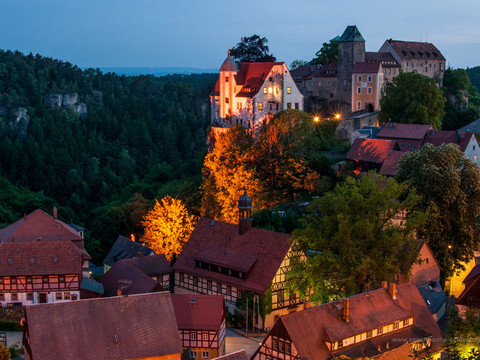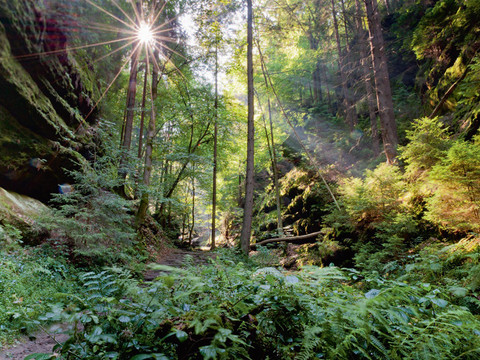The table mountains and peculiar rocks of the Elbe Sandstone Mountains are famous. But romance lives in the valleys, dips, and ravines. Along murmuring brooks and moss-covered stones, the region shows itself at its best.
Oh, it seems we've stumbled right into a gathering of forest spirits. It's easy to imagine that until just now there were dwarves, elves, fairies, nixies, and trolls where countless little stone towers now stand in rock cavities and on boulders. Presumably, they wait out in their camouflage until we intruders finally move on. The place and time would be ideal for a meeting of these shy creatures. The Gautschgrotte near Hohnstein is now, on an early July morning, a magical place. And we have it all to ourselves.
About 20-meter-high rock walls form a natural amphitheater, a surprising dramatic highlight at the end of an overgrown path. The impressive formation, before which we feel tiny and small, demands respect and hushed voices. Only the dripping of the small trickle, which becomes a roaring waterfall after rain and freezes into a monumental ice column in some winters, enlivens the silence.
Solitude is the reward for the early start. Soon the magic of the night, the last remnants of which still hang as morning mist between the trees, will have completely vanished. And the fairy tale realm will have entirely transformed back into the Saxon Switzerland National Park, which opens itself to nature lovers, forest enthusiasts, hikers, and walkers. The search for romance, for the eerily beautiful, brought us here. And it seems we have promptly found both. From the castle town, our hike is supposed to lead us into the Polenz valley and then up to the Brand rock plateau, the "Balcony of Saxon Switzerland." For the Gautschgrotte, we made a small detour.
The dips, valleys, and ravines of the Elbe Sandstone Mountains form the antithesis to the spectacular rock formations, to the table mountains, basalt cones, and viewpoints. Bastei, Königstein, Lilienstein, Pfaffenstein, and Schrammsteine are famous calendar subjects and popular excursion destinations. By comparison, the dips live in the shadows. This is because their real charms are hard or impossible to capture in pictures. The mountains impress with their striking aesthetics even in photos and paintings. The dips, on the other hand, impress mainly through the variety of sensory impressions that can only be experienced on site: the coolness of the air, the scent of the forest, the murmuring of the brooks.
Walking in the dips is something for connoisseurs – and practically a year-round pleasure. Observant hikers discover that every dip, every valley, and every ravine has its own signature, a unique character.
We experience this on our route as well. The Schindergraben, connecting Hohnstein with the Polenz valley, appears rough, wild, and beautiful. Several small bridges cross the crystal-clear stream. Information panels along the way reveal, among other things, that the ground flora here is more species-rich than usual in sandstone areas and that rare fern species, as well as especially many mosses and lichens, thrive here. Probably this is what makes the air here indescribably aromatic.
From the Schindergraben, we reach the Polenz valley. It’s almost like turning from a jungle path onto a promenade. Where the path was still shady and rugged, it is now sunny, wide, flat, and family-friendly. The impressive rock walls here stand far apart. The initially earthy smell soon changes to a mild-woody forest scent. The Polenz has carved out a picturesque valley and a broad, flat bed. The stream glistens peacefully and invitingly in the morning sun today. Fascinating are the lush, green, and densely vegetated rock slopes on the northeast side. Healthy mosses, ferns, grasses, shrubs, and trees are richly supplied with gently and steadily trickling water. The dreamlike valley has been under nature protection since 1940. Dippers, mountain and grey wagtails, bats, and butterflies feel at home here. The March snowflake meadows in the northern part of the Polenz valley have gained supraregional fame. They form one of the largest wild populations of this bellflower species in all of Saxony. Their bloom between early March and early April attracts visitors from near and far every year.
Shortly behind the historic Waltersdorf mill with its cozy beer garden, we cross the stream and soon leave the valley towards Brand. The path leads us through the Schulzengrund. It rises steadily but bearably. After all, there are nearly 180 meters of elevation between the Polenz and the rock plateau. When we pause briefly after about 15 minutes, we suddenly notice how incredibly quiet it has become around us. Somewhere far away, a blackbird sounds an alarm, leaves rustle softly, a few insects buzz. Otherwise, absolute silence.
For city dwellers, this is a sensation. We fall instantly in love with this inconspicuous spot in the Elbe Sandstone Mountains. And the National Park idea reveals itself in all its wonderful breadth. Here in its core zone, we experience the national park not only as a sanctuary for endangered species but also as an oasis for endangered feelings. Where the noise of progress falls silent, we may listen again to the quiet tones of the essential.
Happy and satisfied, we finally arrive at Brand, where the first day-trippers are already settling in for lunch. Here, one last magnificent panoramic view of the Polenz valley offers itself, which we briefly enjoy before starting the return journey to Hohnstein. We are not in the mood for bustle right now. We'd rather let the nature experience linger a bit longer. The last leg of the circular hike is a wide, paved forest path without significant inclines. At the Eiche park and bus stop, the circle closes again for us.
A few days later, we learn that there are people who firmly believe that the Elbe Sandstone Mountains have numerous so-called "power places," places where the "earth's energy" concentrates and the perception of nature is especially intense. If that’s true, then during our hike, we have discovered some of these.

